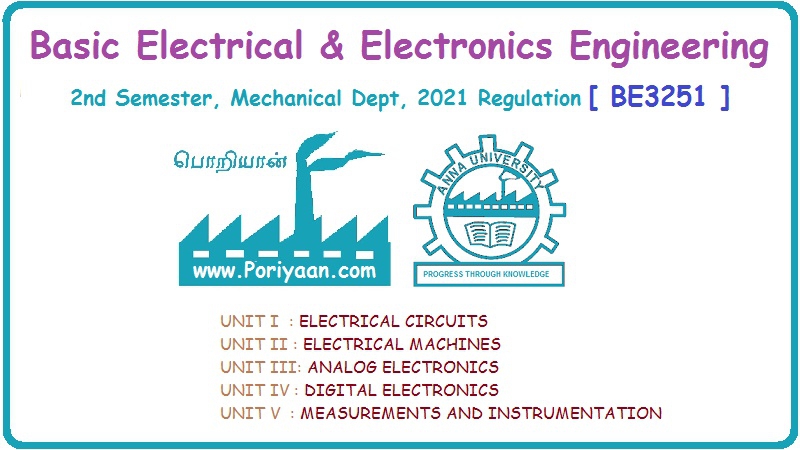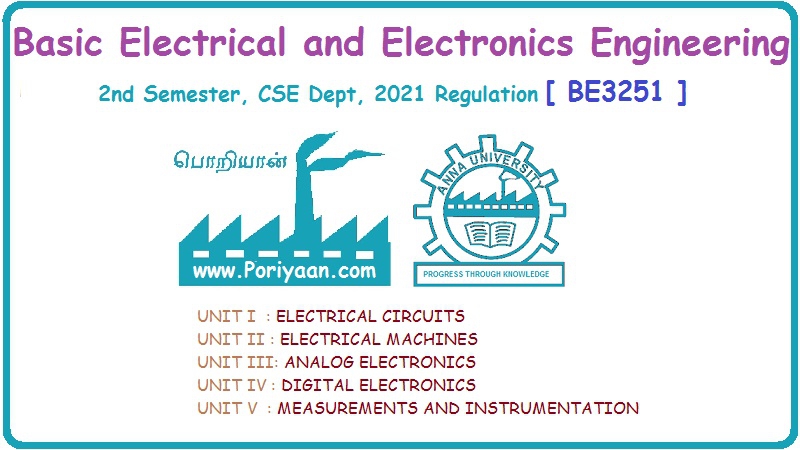Basic Electrical and Electronics Engineering: Unit II: Electrical Machines
Types of DC Motors
with Solved Example Problems
The field winding is excited by a separate DC source.The connection diagram of a separately excited DC motor.
TYPES OF DC MOTORS
Separately excited DC motor
The field winding is excited by a separate DC source. Fig 3.26 shows the connection diagram of a separately excited DC motor.
From the fig 3.26
Back emf, Eb = V - IaRa - Vbrush
Armature current Ia = line current IL
Vbrush is neglected because of very small value.
DC series motor
Fig 3.27 shows the connection diagram of a DC series motor. In DC series motor the field winding is connected in series with the armature.
The voltage equation is
V = Eb + IaRa + IseRse + Vbrush
Here
Armature current, Ia = Series field current, Ise - Line current, IL
V = Eb + Ia (Ra + Rse) + Vbrush
Normally Vbrush is neglected.
In a series motor, flux produced is directly proportional to the armature current.
ϕ α Ise α Ia
DC shunt motor
Fig 3.28 shows the connection diagram of a DC shunt motor.
The line current IL is divided into two parts one through the field winding and second through the armature.
IL = Ia + Ish
Ish = V / Rsh
Voltage equation of a DC shunt motor is
V = Eb + IaRa + Vbrush
In shunt motor, flux produced by field winding is proportional to the field current Ish
ϕ α Ish
DC shunt motor is called a constant flux motor or constant speed motor.
Compound motor:
The DC compound motor consists of both series and shunt field windings.
(a) Long shunt compound motor:
In this motor the shunt field winding is connected across both armature and series field winding. Fig 3.29 shows the connection diagram of a long shunt compound motor.
Line current
IL = Ise + Ish
Ise = Ia
IL = Ia + Ish
Ish = V / Rsh
The voltage equation is
V = Eb + IaRa + IseRse + Vbrush
Ia = Ise
V = Eb + Ia (Ra + Rse) + Vbrush
(b) Short shunt compound motor
In this motor the shunt field winding is connected across the armature and series field winding is connected in series with this combination.
Figure 3.30 shows the connection diagram of a short shunt compound motor.
IL = Ise ,IL = Ia + Ish
IL = Ise = Ia + Ish
The voltage across the shunt fiels winding is
V = Eb + IaRa + IseRse + Vbrush
Ise = IL
V = Eb + IaRa + ILRse + Vbrush
Voltage drop across shunt field winding is
= V - ILRse
Vsh = Eb + IaRa + Vbrush
Ish = V - ILRse / Rsh
Example: 8
A 230 V, DC shunt motor takes a total current of 25 A from the supply lines. The resistance of the shunt field circuit is 200Ω And that of the armature is 0.3Ω. Find the armature current and back emf.
V = 230 V, IL = 25 A, R = 200 Ω, Ra = 0.3 Ω
Shunt field current, Ish = V/Rsh Ω
= 230/200 = 1.15A
Armature current, Ia = IL - Ish
= 25 - 1.15
Ia = 23.85 A
Back emf, Eb = V - IaRa
= 230 - 23.85 × 0.3
= 222.84 V
Example: 9
A four pole, 250 V, series motor has a wave connected armature with 1254 conductors. The flux per pole is 22 mwb. The motor takes an armature current of 50 A. Armature and field resistances are 0.2Ω and 0.2Ω repectively. Calculate its speed.
P = 4, V = 250 V, = 22 mwb, Z = 1254,
Ia = 50A, Ra = 0.2Ω, Rse = 0.2Ω
For wave connected, A = 2
Eb = V - Ia (Ra+Rse)
= 250 - 50(0.2 + 0.2)
= 250 - 20
N = 250.10 rpm
Example: 10
A 10 kw, 250V DC shunt machine has an armature and field resistances of 0.1Ω and 125Ω respectively. Calculate the total armature power developed when running
(i) As a motor taking 10 kw input
(ii) As a generator delivering 10 kw as output V = 250V, P = 10 kw, Ra =0.1Ω, R sh = 125Ω.
(i) As a motor taking 10 kw input
Line current, IL = P/V = 10 × 103 / 250
IL = 40 A
Shunt field current, Ish = V/Rsh
= 250/125
Ish = 2A
Armature current, Ia = IL - Ish
= 40 - 2
Ia = 38 A
Back emf, Eb = V - IaRa
= 250 - (38 x 0.1)
Eb = 246.2 V
Power developed in the armature,
P = EbIa
= 246.2 × 38
= 9355.6 W
P = 9.35 kw
(ii) As a generator delivering 10 kw output
Load current, IL = P/V
= 10 × 103 / 250
IL = 40 A
Shunt field current, Ish = V/Rsh
= 250/125
Ish = 2A
Armature current, Ia = IL + Ish
= 40+2
Ia = 42 A
Generated emf,
Eg = V + Ia Ra
= 250 + 42 × 0.1
Eg = 254.2 V
Power developed in the armature = EgIa
= 254.2 × 42
= 10676.4 W
= 10.67 KW
Example: 11
The armature of a DC machine has a resistance of 0.1Ω and is connected to a 230 V supply. Calculate the back emf when it is running (i) as a generator giving 80 A (ii) as a motor taking 80 A.
Ra = 0.1Ω, I = 80 A
V = 230 V
(i) As a generator giving 80 A
Eb = V + IaRa
=230 + (80 × 0.1)
Eb = 238 V
(ii) As a motor taking 80 A
Eb = V - IaRa
= 230 (80 × 0.1)
Eb = 222 V
Basic Electrical and Electronics Engineering: Unit II: Electrical Machines : Tag: : with Solved Example Problems - Types of DC Motors
Related Topics
Related Subjects
Basic Electrical and Electronics Engineering
BE3251 2nd semester Mechanical Dept | 2021 Regulation | 2nd Semester Mechanical Dept 2021 Regulation
Basic Electrical and Electronics Engineering
BE3251 2nd Semester CSE Dept 2021 | Regulation | 2nd Semester CSE Dept 2021 Regulation

